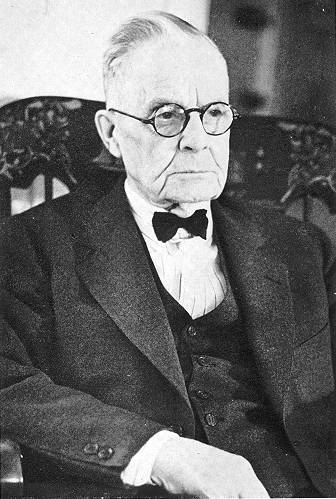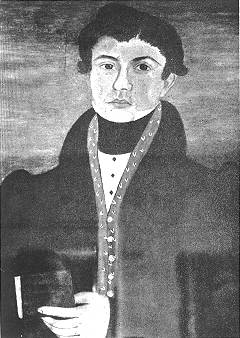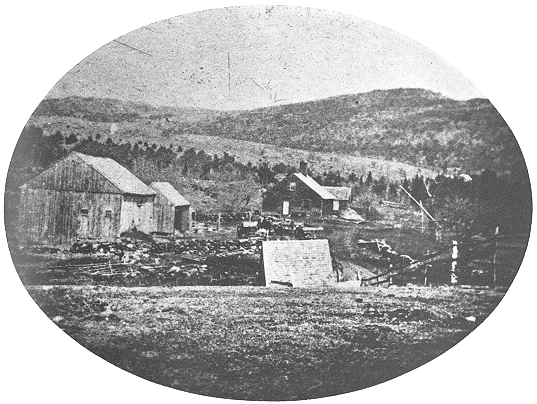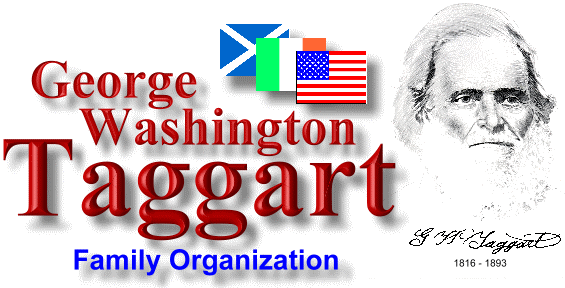Documentary Film
George Washington Taggart
The Salt Lake City Years
Research Notes and Liner Notes
for The Music of John A Taggart
by Randy
Miller
William Copeley, librarian at the New Hampshire Historical Society, got
me going on John A. Taggart and his fiddle music by allowing me to bring my
fiddle into the basement of the Historical Society building. There I opened
Taggart's autobiography and read through every hand-written tune, noting
down ones that were unfamiliar to me. These tunes formed the basis for the
"Music of John Taggart" cassette, recorded in 1989. Today, his old
tunes are being re-circulated among contra dance musicians, serving to
inspire modern-day contra dancers, and 18 of his tunes are included in my
recently-published fiddle tune book, "The
Fiddler's Throne."
Trips to Sharon, where J. A. Taggart grew up, and Millers Falls,
Massachusetts, where he spent the last years of his life, gave me further
information on his life and times. I managed to unearth the Taggart cellar
hole deep in the woods and puckerbrush of Sharon. I met and talked with
Adrian Savage of Millers Falls, an acquaintance of Taggart, who showed me
his collection of old newspaper clippings about Taggarat. He also took me to
the local cemetery to see the Taggart grave stones. A few years ago, Stephen
Greene, an ethnomusicologist, sent me a tape containing some fiddling of
John Taggart that was recorded in the 1940s just a few years before his
death. The fiddling is crisp, energetic, and full of character, reflecting
I'm sure the personality of John Taggart.

John Adams Taggart 1854-1943*
[Following are the liner notes to The Music of John Taggart by the New
Hampshire Fiddlers Union. Written by and copyright © 1989 Randy Miller.]
| The New Hampshire Fiddlers Union is thrilled to
present these 25 vintage, somewhat obscure contra dance tunes. As
revealed in the priceless memoirs of John Adams Taggart (1854-1943).
His Recollection of a Busy Life, a typewritten manuscript
completed in 1938 and recently acquired by the New Hampshire
Historical Society, portrays in rich detail his family and
neighbors, their way of life, and hi own youth in the tiny town of
Sharon, New Hampshire. John Taggart grew up surrounded by music and
song, became a fiddler, and eventually wrote down in his book some
71 dance tunes and 18 ballads.
We are attempting to bring back to life a portion of this legacy
of traditional music, and we can do no better than echo John
Taggart's own understated words about the tunes: "they were all
taught me during my boyhood days in Sharon, by the various
'fiddlers' in the vicinity…I trust someone may find them of
interest."
John A., the youngest of 8 children, was the fifth generation
Taggart to reside in Sharon. The original Taggart was Scotch-Irish,
that is, a Scotsman from the north of Ireland, who came to
Massachusetts Bay about 1740 but soon struck out for the wilds of
New Hampshire. John A.'s mother's ancestors were 17th-century
Massachusetts Bay colonists named Piper. John Taggart's maternal
grandmother Pettis (1789-18670 lived with the family in her old age,
and he recalls her singing the "songs of her own and former
periods." She sang ballads, rhymes and spinning songs. Indeed,
to the boy, the whirring of the spinning wheel itself was music. His
father, Phineas Taggart, (1812-1892), farmed 140 acres at the foot
of Temple Mountain, with a splendid view of Mount Monadnock to the
northwest. He was a fiddler and dancing master in the 1830's and
40's, teaching in all the surrounding towns. Phineas was a great
lover of Burns, whose poems he could recite at length, and "was
much given to using quaint Scotch words…He was a beautiful dancer…my
mother was also an extremely graceful dancer."

Phineas B. Taggart*
Dancing was second nature to the Taggarts and certain of their
neighbors, an unquestioned social event amidst the week's agenda.
Either at the local dance hall, or more likely, in the Taggart's
kitchen, 4 or 5 families would gather, old and young mingling in
"the mazy dance." They new "Quadrilles" but
danced mostly contras, the figures of which were known by heart. One
fiddler with good timing was considered sufficient for the music.
Refreshments were served at midnight and daybreak. The dancers of
his parent's generation "had certain 'steps' for every bar of
the tune, and every motion was grace personified, and their
deportment may be described by the one word Courtly. I take it that
their style of dancing was identical with that of Washington's
time." His father danced hornpipes and reels to a slow tempo
and could execute the Pigeons Wing, a balance step using 4 bars of
music, describes as a "winking" of first the right, then
the left foot, so complicated "not one in a hundred could
master it." Other showy balance steps had names like High Betty
Martin, Double Shuffle, tip Top Five, Ten Step, Braise (invented by
a neighbor Joe Barnes which consisted of spinning around 2 or 3
times on the left foot "followed by bewildering flourishes with
the right."), and the Cooper Step (made up by Jesse Spofford
wherein the dancer jumps up, crashes his boot heels together in
midair, then thumps on the floor "for rhythm's sake"). The
spruce floor boards in the Sharon kitchens, John A. relates, got
worn down until the slippery knots stuck up.

Phineas B. Taggart Farm*
John Taggart took up the violin at age 12, practicing in the old
barn, tutored by an older brother. He formed a fiddle, fife, and
drum band with the White boys, and by age 15 was playing for dances.
Fiddlers abounded in Sharon, all within walking distance of John
A.-besides his father and brother, there were Isaac White and the
Barnes brothers, Joe and Warren. Some year later, while working as
an iron molder in Greenfield, Massachusetts, he took formal violin
lessons, and "every moment outside the shop was employed in
study and practice." He joined Putnam's Orchestra in 1877,
which had 1st and 2nd violins, cornet, two clarinets, trombone and
bass. John Putnam was the famous Franklin County, Massachusetts,
prompter and left-handed fiddler, a run-away slave. John A. played
1st violin in another local orchestra, Steigleder's, until 1881 when
he married seventeen-year-old Nena King whose dancing aura had
transfixed him from the stage. That year he formed his own group,
Taggart's Orchestra, playing all over western Massachusetts for the
next 14 years. The tunes in his Recollection "were all played
by Taggart's Orchestra." John A. gave up music as a business in
1895, thereafter playing "only as a pastime" and with his
two children. His library of dance music was destroyed in a fire in
1895, but his violin, a "Kurkshaw" made in 1802 which cost
"125.00 was saved.
Forced by poor prospects to leave his father's worn-out farm in
his twenties, John A. applied himself to many trades: foundryman,
livery owner, carriage painter, auctioneer, and finally Street
Railway executive. He kept in touch with his native New Hampshire by
frequent visits. He died in 1943 at the age of 88. Nothing further
than his own written memoir can reveal more of the music, dancing
and life of John Adams Taggart in 19th-century Sharon, for he has no
surviving direct descendants. Yet it contains a tremendous tale, and
enough uncanny wisdom to have insured at least the survival of his
music.
-Randy Miller, September 1989
Quotes are from Taggart's Recollection |
*Photographs from the book, Sliptown - The History of Sharon
New Hampshire 1738-1941. King, H Thorn Jr., Charles E Tuttle Co., Inc.
Rutland VT, Tokyo, Japan. 1965
|
